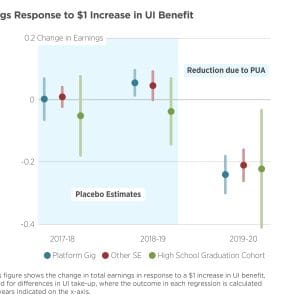The winter 2016 meeting was hosted by Volatility Institute at New York University’s Stern School of Business.
This research project is supported by a generous grant from the Alfred P. Sloan Foundation and CME Group Foundation.
Agenda
The Impact of the Housing Market on the Macroeconomy
Antoinette Schoar and coauthors find that it was actually middle-class and high-income households—not poorer subprime borrowers—who defaulted more and started the debt cascade that became a crisis.
This work revised earlier findings of Amir Sufi and Atif Mian (2009). Sufi was on hand to present new work that also challenged standard thinking. Contrary to standard macroeconomic models, Sufi’s paper shows that a rise in the ratio of household debt to GDP can predict a global economic downturn.
Schoar began the session by noting the financial crisis is generally viewed as a result of a supply-side problem with credit provision to poor subprime borrowers. “But subprime almost a misnomer,” Schoar told the audience “The idea that credit was misallocated to poorer borrowers not what we are finding.”
Instead, her data show that leading up to the crisis, credit expanded across the income distribution. Subprime borrowers did default more in the early phase; for loans originated in 2003, households in the bottom 20 percent of the income distribution held 11 percent of mortgage dollars, but by 2006 they accounted for 22 percent of default dollars.
That quickly reversed. “Once the crisis hit, we see a sharp increase in delinquency for middle-class and prime borrowers after 2007, but not so much for subprime loans.” By 2009, the upper two income brackets accounted for half of the default value—up from 32 percent.
Schoar’s data showed a buildup in household leverage before 2006, driven by cash out refinancing and second mortgages but again, it was the richest households demanding credit.
This result differs from Mian and Sufi (2009), who attributed the crisis to subprime borrowers because they found more mortgages were written in areas where income growth was declining. Schoar and colleagues looked more closely at micro-data, teasing out differences driven by the value of mortgages rather than the sheer number driven by quick re-sales or “churn” in real estate markets. There they found a strong positive relationship between mortgage credit and income growth.
This trend was especially true in regions with high home price growth, Schoar said, which supports an expectations-driven boom. “The results open door to interpretations that homeowners bought into expectations of housing price increases. This is consistent with a view that there was a systemic build-up in risk that led to defaults when the economy slowed down,” she said.
Discussant Nancy Wallace highlighted the major difference in Schoar’s work: moving away from representative zip code data and instead analyzing loan-level Home Mortgage Disclosure Act data.
Hammond and colleagues have taken this work one step further, merging in loan performance data. “Our work also shows more default in high-income borrowers. It’s a very striking result that completely supports result of this paper,” she said.
The finding has important policy implications, because the post-crisis response largely aimed at revising relaxed credit standards for poor.
If in fact subprime borrowers were not the ones defaulting, “the focus should be on macroprudential policy,” Hammond said.
High household debt, lower growth
Amir Sufi, whose work on the role of household debt in the US financial crisis was widely cited, took a longer, more global view in the paper presented. He found that a rise in household debt predicts lower output growth and higher unemployment over the medium-run.
The paper analyzes household debt levels in 30 OECD countries between 1960 and 2012, for a total of 900 country years. It shows that an increase in household debt in a period from years previous until last year “does a pretty good job of predicting GDP decline from this year to three years out,” Sufi said.
Sufi said that there has been a lot of excellent research in this area, but much of it is based on data limited to the financial crisis. But much of that work was based on data from the financial crisis “and was conditional on having a recession. Ours is unconditional,” he said.
The rise in household debt, where it’s occurring, coincides with a consumption boom, Sufi said. From the data it’s possible to clearly delineate household debt from firm debt. “It does not look like an investment boom at all.”
They found that larger increases in household debt caused even bigger decline in growth. Sufi called the effect “strong and surprising,” saying that he had been skeptical of similar models.
The analysis shows that a rising household debt to GDP ratio is also associated with a rising consumption share of output, a worsening of the current account balance, and a rise in the share of consumption goods within imports. This is followed by strong external adjustment when the economy slows as the current account reverses and net exports increase due to a sharp fall in imports.
Sufi said that the predictive strength of rising household debt could be used to predict forecasting errors in International Monetary Fund and OECD forecasts for future GDP.
“What’s striking is that spreads at time T–minus four years is telling you something about what’s going to happen eight years from now. That’s a surprising result,” said discussant Simon Gilchrist of Boston University.
He suggested that Sufi and colleagues should think a bit more about causality and amplification of boom-bust cycle effect. The paper’s evidence on causality” is convincing to many but for purists still lacking an instrument,” Gilchrist said. “Robustness to emerging market economies provides further evidence of relevance and causality.”
Some in the audience questioned the focus on household debt as a sound predictor and wondered if this was simply a pattern observed within economic cycles.
Financial Stability and Central Banks
Central banks and regulators work to promote stability with tools like stronger capital requirements and leverage limits. But they need better models to fully understand the long-term impact of these tools. This session offered two steps in that direction.
Nataliya Klimenko of the University of Zurich presented a model of bank lending that showed that when banks are undercapitalized, they lend too much, because they do not internalize the impacts of their decisions on expected profits. Requiring a minimum capital ratio helps taming excessive lending, the model shows. Relatively high minimum capital ratios enhance financial stability, but mild capital requirements may destabilize the system. Discussant Lars Peter Hansen called for further work to extend the model for use in dynamic systems; for policy implementation, he called for more specific definitions of capital reserve requirements.
Turning to the “too-interconnected-to-fail” issue, Michael Gofman modeled a trading network to estimate the tradeoff between stability and efficiency. He found that limiting network size does increase stability, but at the cost of decreased trading efficiency, because the chains of counterparties become longer. Stability also increases with higher liquidity requirements and access to liquidity.
The ambitious paper uses the network of interbank trades to create an equilibrium model of lending and connections, said discussant Andrew W. Lo. He noted that he’d like to see a time dimension incorporated in the model, and wondered if it could capture the contagion dynamics of bank runs and fire sales.
Lunch Speaker
Break
Big Data, Macroeconomics, and Systemic Risk
- “A Multi-Layer Network Perspective on Systemic Risk”
Frank Schweitzer, ETH Zurich - “The Billion Prices Project: Measuring Real Time Inflation”
Alberto Cavallo, Massachusetts Institute of Technology
Executive Session (Working Group Only)
Machine Learning and Applications in Finance and Macroeconomics
- “Deep Learning for Mortgage Risk”
Kay Giesecke, Stanford University - “Risk and Risk Management in the Credit Card Industry: Machine Learning and Supervision of Financial Institutions“
Akhtar Siddique, Office of the Comptroller of the Currency
- “Mortgage and Housing Microdata: Database Construction and Challenges for Statistical Inference”
Nancy Wallace, University of California, Berkeley
Young Scholars Session 1 and Lunch
- “Do Financial Factors Drive Aggregate Productivity? Evidence from Indian Manufacturing Establishments”
Aaron Pancost, University of Chicago - “Approximating Markov Equilibria with Heterogeneous Agents and Incomplete Markets”
Elisabeth Prohl, Geneva School of Economics
- “Demand Shocks in the Housing Boom and Bust”
Jack Lieberson, MIT
- “Debt Runs and the Value of Liquidity Reserves”
Fabrice Tourre, University of Chicago
- “The Effects of Quantitative Easing on Bank Lending Behavior”
Alex Rodnyansky, Princeton
Young Scholars Session 2
- “Lifetime-Laffer Curves and the Eurozone Crisis”
Zachary Stangebye, University of Notre Dame - “The Role of Dispersed Information in Pricing Default: Evidence from the Great Recession”
Marco Macchiavelli, Federal Reserve Board
- “Financial Regulation in a Quantitative Model of the Modern Banking System”
Juliane Begenau, Harvard Business School











